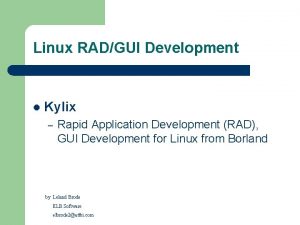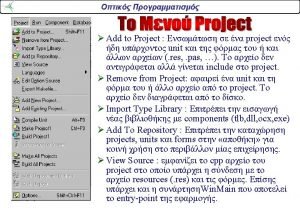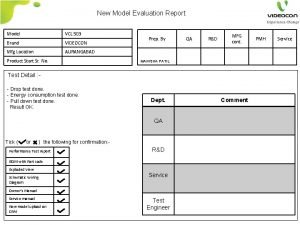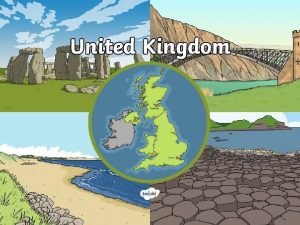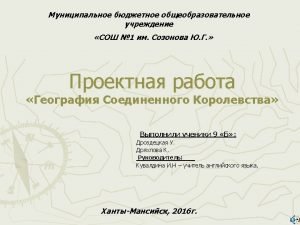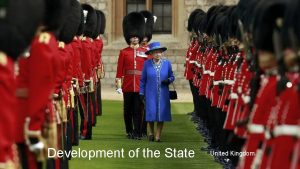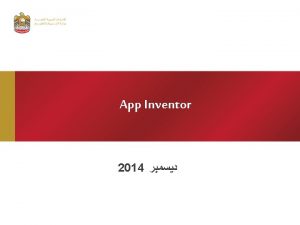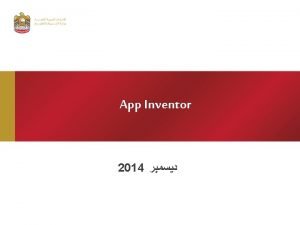VCL and AN v United Kingdom App 7758712




















- Slides: 20


VCL and AN v United Kingdom, App 77587/12 and 74603/12 Emma Fitzsimons, Garden Court Chambers Philippa Southwell, Southwell & Partners 24 February 2021 @gardencourtlaw

Context – prevalence of child trafficking/modern slavery in the UK • Significant numbers of children are trafficked in the UK – latest NRM statistics show in the last quarter, 49% of referrals were for potential child victims • As acknowledged by Underhill LJ in R (TDT) v SSHD [2018] EWCA Civ 1395 at para 40: “Trafficking is a process and not a single event. A victim of trafficking who is encountered in the back of a lorry or found working at a cannabis farm or a nail bar will not only have been trafficked in the preceding period but will also be at real and immediate risk of the trafficking continuing; even if a victim has escaped, or been removed, from the immediate control of their traffickers, he or she will very commonly still be sufficiently under their influence to be at real and immediate risk of re-trafficking if not afforded proper support and protection. ” • See also para 82: “being a past victim of trafficking and being at real and immediate risk of being (re-) trafficked are very closely inter-related. ” @gardencourtlaw

VCL – an example of what can go wrong for child victims in the CJS VCL • Vietnamese child encountered 2009 by police during a drugs raid, in locked residential premises converted into a cannabis factory • In interview described being trafficked and stated he was a child, 15 years old • The Competent Authority and the Local Authority identified him as a credible victim of trafficking • CPS disagreed with that assessment, maintained the decision to prosecute • Nonetheless – guilty plea resulted in a conviction and being sentenced to 20 months’ in a young offenders’ institution @gardencourtlaw

VCL – an example of what can go wrong for child victims in the CJS • Appealed to Court of Appeal in 2012 – dismissed • CCRC reference – fresh evidence and legal submissions as to position of children as victims of trafficking and failures to investigate • Differently constituted Court of Appeal in 2017 – dismissed again! • Court of Appeal refused to certify points of law to Supreme Court • Amended application to ECt. HR in 2017: • Central plank – failure to investigate/identify him by domestic prosecution authorities resulted in breach of Articles 4 and 6 ECHR @gardencourtlaw

Decision of the ECt. HR • Handed down on 16 February 2021 • Chamber decision – not yet final • Found there had been violations of Article 4 (prohibition of forced labour) and Article 6(1) (right to a fair trial) in both VCL and AN • Decision is first time considered the relationship between Article 4 and the prosecution of VOTs/PVOTs • Interventions from Anti-Slavery International, Liberty and GRETA @gardencourtlaw

Article 4 ECHR – principles Confirms “means” element is not necessary for a child victim (para 149) Definition of forced labour – will be fact sensitive: “Similarly, the question whether an individual offers himself for work voluntarily is a factual question which must be examined in the light of all the relevant circumstances. However, the Court has made it clear that where an employer abuses his power or takes advantage of the vulnerability of his workers in order to exploit them, they do not offer themselves for work voluntarily. In this regard, the prior consent of the victim is not sufficient to exclude the characterisation of work as forced labour. ”(para 149) Re-states that positive obligations must be construed in light of ECAT as interpreted by GRETA, and Art 4 like Arts 2 and 3 will, in some cases, impose operational measures to protect potential or actual victims. Operational measures must be interpreter in a way that does not impose an impossible, disproportionate burden on authorities (para 152 -156) @gardencourtlaw

Prosecution of VOTs No general prohibition to prosecute – Art 26 ECAT only provides for possibility of non-punishment. Compulsion does not appear to be necessary for a child (para 158) In certain cases, prosecution will be contrary to state’s duty to take operational measures to protect: “The Court considers that the prosecution of victims, or potential victims, of trafficking may, in certain circumstances, be at odds with the State’s duty to take operational measures to protect them where they are aware, or ought to be aware, of circumstances giving rise to a credible suspicion that an individual has been trafficked. In the Court’s view, the duty to take operational measures under Article 4 of the Convention has two principal aims: to protect the victim of trafficking from further harm; and to facilitate his or her recovery. It is axiomatic that the prosecution of victims of trafficking would be injurious to their physical, psychological and social recovery and could potentially leave them vulnerable to being re-trafficked in future. Not only would they have to go through the ordeal of a criminal prosecution, but a criminal conviction could create an obstacle to their subsequent integration into society. In addition, incarceration may impede their access to the support and services that were envisaged by the Anti-Trafficking Convention. ” (para 159) @gardencourtlaw

Early identification is key “In order for the prosecution of a victim or potential victim of trafficking to demonstrate respect for the freedoms guaranteed by Article 4, his or her early identification is of paramount importance. It follows that, as soon as the authorities are aware, or ought to be aware, of circumstances giving rise to a credible suspicion that an individual suspected of having committed a criminal offence may have been trafficked or exploited, he or she should be assessed promptly by individuals trained and qualified to deal with victims of trafficking. That assessment should be based on the criteria identified in the Palermo Protocol and the Anti-Trafficking Convention (namely that the person was subject to the act of recruitment, transportation, transfer, harbouring or receipt, by means of threat of force or other form of coercion, for the purpose of exploitation) having specific regard to the fact that the threat of force and/or coercion is not required where the individual is a child (see paragraphs 94 and 102 above). ” (para 160) @gardencourtlaw

Unique position of children “Moreover, given that an individual’s status as a victim of trafficking may affect whethere is sufficient evidence to prosecute and whether it is in the public interest to do so, any decision on whether or not to prosecute a potential victim of trafficking should – insofar as possible – only be taken once a trafficking assessment has been made by a qualified person. This is particularly important where children are concerned. The Court has acknowledged that as children are particularly vulnerable, the measures applied by the State to protect them against acts of violence falling within the scope of Articles 3 and 8 should be effective and include both reasonable steps to prevent illtreatment of which the authorities had, or ought to have had, knowledge, and effective deterrence against such serious breaches of personal integrity (see, for example, Söderman v. Sweden [GC], no. 5786/08, § 81, ECHR 2013; M. P. and Others v. Bulgaria, no. 22457/08, § 108, 15 November 2011; and Z and Others v. the United Kingdom [GC], no. 29392/95, § 73, ECHR 2001‑V). Such measures must be aimed at ensuring respect for human dignity and protecting the best interests of the child (see Söderman, cited above, § 81). Since trafficking threatens the human dignity and fundamental freedoms of its victims (see Rantsev, cited above, § 282), the same is also true of measures to protect against acts falling within the scope of Article 4 of the Convention. ” (para 161) @gardencourtlaw

Application to VCL’s facts Article 4 ECHR VCL found in cannabis factory as a child – trafficking suspected – yet he was charged with being in concerned in production of controlled drug – ought to have been referred into NRM. Concerns also flagged by the Local Authority (paras 164 -164) CPS reviewed decision to prosecute – maintained – not credible that he had been trafficked; no further reasoning shared with ECt. HR (para 166) CA’s review after conviction did not change his status as trafficked victim - (para 168) Refers to the evidence of Vietnamese minors being particularly vulnerable at that time – would have been open to the CPS on basis of clear reasons consistent with the definition in Palermo Protocol and ECAT to have disagreed with the positive CG decision. Neither of those things happened. ” (para 172) The Court find violation of Article 4 ECHR (para 173 -174) @gardencourtlaw

Application to VCL’s facts Article 6 ECHR In determining whethere has been a violation of Art 6 the question for the Court to determine: “…first of all, did the failure to assess whether the applicants were the victims of trafficking before they were charged and convicted of drugs-related offences raise any issue under Article 6 § 1 of the Convention; secondly, did the applicants waive their rights under that Article by pleading guilty; and finally, were the proceedings as a whole fair? ” (para 194) Evidence of a VOT’s status is a fundamental aspect of the defence which he or she should be able to secure without restriction (para 196) Whilst the defence legal reps could have referred the cases to the NRM, their failures to recognise or act on such indicators cannot by itself absolve the state and its agents of its responsibility to do so (para 198) Failure to conduct timely assessment of trafficking is also a violation of Art 6 (para 200) Guilty plea did not amount to a waiver of right to fair trial (paras 201 -204) - the trial could not therefore be fair (para 205 -210) @gardencourtlaw

Practical issues and flashpoints for practitioners • Arrest, charge and prosecution: early identification – NRM referral; requests reconsideration and judicial review • Trial – representations to discontinue prosecution in public interest; section 45 MSA defence; abuse of process; • Sentencing – vulnerability, culpability and positive obligations for recovery under Article 4 ECHR • Post-conviction? – Out of time appeals, CCRC references • Compensation and civil claims for unlawful detention, failure to protect, personal injury etc • Immigration status – revocation of deportation order; discretionary leave as a VOT; asylum and human rights claims @gardencourtlaw

Trafficking indicators – in practice ü Showing signs that their movement has been restricted or ü Physical signs of abuse such as scaring malnourishment, monitored migraines, tattoos and branding on the skin ü Unable to recall facts about identity, location or situation ü Often report and evidence of older individuals present during ü Giving false accounts to authorities the commission of the offence üPeriods of missing ü Believe that they must work against their will ü Giving the impression they’re bonded by debt ü Be unable to leave their work environment ü Being ashamed of having committed a criminal act ü Show signs that their movements are being controlled ü Being fearful, anxious, withdrawn and/or apathetic ü Feel that they cannot leave ü Showing signs of physical, emotional or sexual abuse ü Show fear or anxiety ü Living in undignified/cramped conditions/malnourishment ü Be subjected to violence or threats of violence against ü Speaking as though they’ve been coached/instructed themselves or against their family members and loved ones üGoing missing from care or missing episodes ü Suffer injuries that appear to be the result of an assault ü Hiding phones or sim cards ü Showing fear for family in country of origin ü Exhibiting distrust of the authorities üOften receiving phone calls when at court ü Pressure to plea guilty to offences and sudden changes in plea ü Inconsistent about age ü Inconsistent accounts @gardencourtlaw

Risks and current failures in the criminal justice context • The police, prosecution and defence lawyers are failing to identify cases where the individuals have a right to not be prosecuted and many are advised to plead guilty • Currently we continue to prosecute victims of trafficking that have been forced into criminality • We fail to identify them at first instance and rather than interview then as a victim we interview as suspects under caution • Lack of Information sharing between various bodies. • Serious risk of re-trafficking • Denial of international protection such as immigration detention, removal and recognition as a victim of trafficking • Physical health, mental health and welfare resulting from the failure to provide appropriate support • Re-affirming mistrust of authority figures @gardencourtlaw

Best practice approach • A trafficked victim may be reluctant to reveal their trafficking history until trust has been established. This may take a number of meetings and require a sensitive approach. • Be mindful when taking accounts information for risk of re-traumatisation, many victims will suffer from post traumatic stress disorder and other physical and psychological issues as a result of their exploitation. • Be aware that inconsistencies given as to their account, age, names etc are also a trafficking indicator and do not necessarily mean that your client is not credible. Often there are inconsistencies as a result of the trauma they have experienced, but it is also common that they have been instructed by their trafficker to give a certain account if apprehended. @gardencourtlaw

Exploitation typologies and common methods (i) Victims of modern slavery are preyed upon due to a backdrop of complex issues. It is not possible to document all forms of exploitation in a short format, and there is no definitive list. Common forms of exploitation in the UK are forced criminality, sexual exploitation, forced labour and domestic servitude. Traffickers are often professional criminals and will seek to exploit vulnerable people wherever they can. Just as exploitation can come in many forms, so does vulnerability. Each has its own business model, trafficker profiles, recruitment strategies, victim profiles and methods of control that facilitate human trafficking. The NCA 2016 statistics only records domestic servitude, labour exploitation, sexual exploitation and unknown exploitation type as forms of exploitation in the UK. The Crown Prosecution Service (CPS) guidance on human trafficking acknowledges that exploitation typologies, particularly involving children, are often varied and can include: • domestic servitude; • labour exploitation; • criminal activity (eg cannabis cultivation, petty street crime, illegal street trade, drug mules etc); • sexual exploitation (brothels, closed community, for child abuse images); • application of residence; • benefit fraud; • forced begging; • illegal adoption; and • sham marriages. @gardencourtlaw

Exploitation typologies and common methods (ii) Perpetrators use a variety of control methods to engage or coerce vulnerable individuals. • Physical and sexual violence • Deception • Debt • Isolation • Dependency • Emotional control • Culture and faith • Family involvement @gardencourtlaw

Further Reading @gardencourtlaw

Thank you 020 7993 7600 info@gclaw. co. uk @gardencourtlaw
 Old kingdom middle kingdom new kingdom
Old kingdom middle kingdom new kingdom Old kingdom middle kingdom new kingdom
Old kingdom middle kingdom new kingdom Roman empire
Roman empire Mentohotep
Mentohotep Agner fog
Agner fog Vcl linux
Vcl linux #pragma hdrstop
#pragma hdrstop Vcl brand
Vcl brand Similarities between protists and fungi
Similarities between protists and fungi Share
Share Kingdom fungi and kingdom plantae similarities
Kingdom fungi and kingdom plantae similarities What is the odds and ends kingdom
What is the odds and ends kingdom What is the full name of uk
What is the full name of uk Great britain and uk difference
Great britain and uk difference United kingdom
United kingdom Security vetting services
Security vetting services United kingdom 5 countries
United kingdom 5 countries What does britain consist of
What does britain consist of The united kingdom is made up of
The united kingdom is made up of What does the united kingdom consist of
What does the united kingdom consist of National flower of united kingdom
National flower of united kingdom





